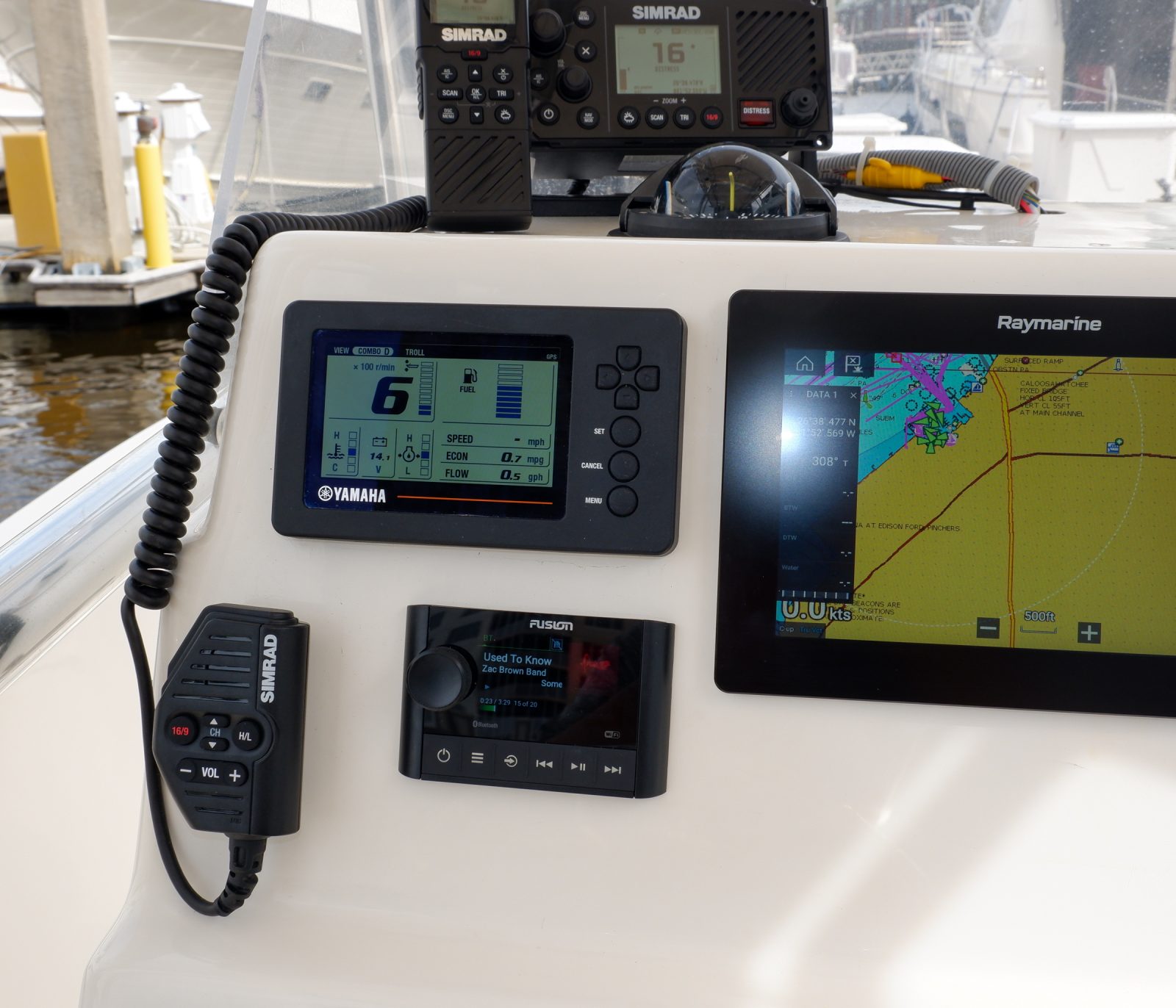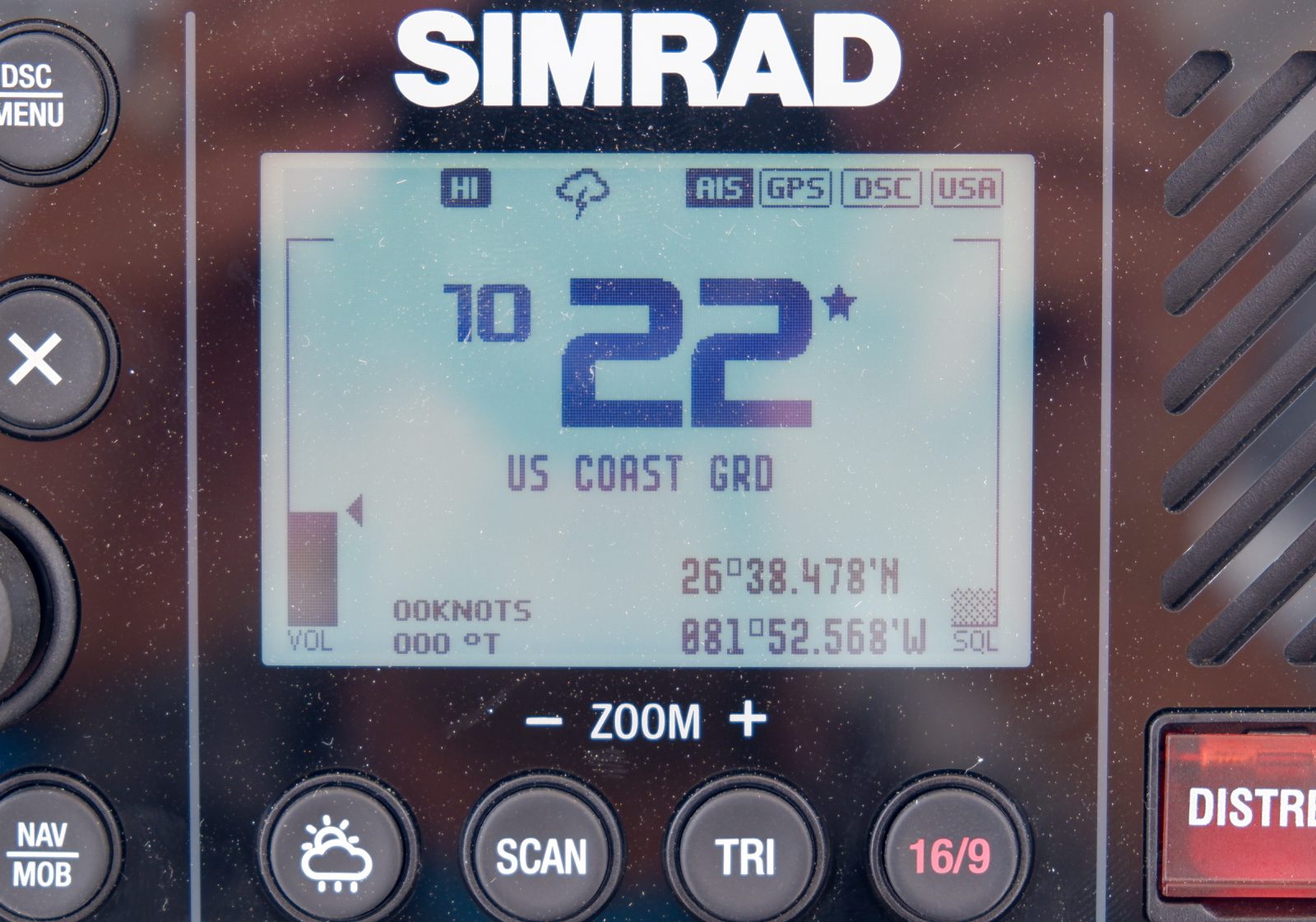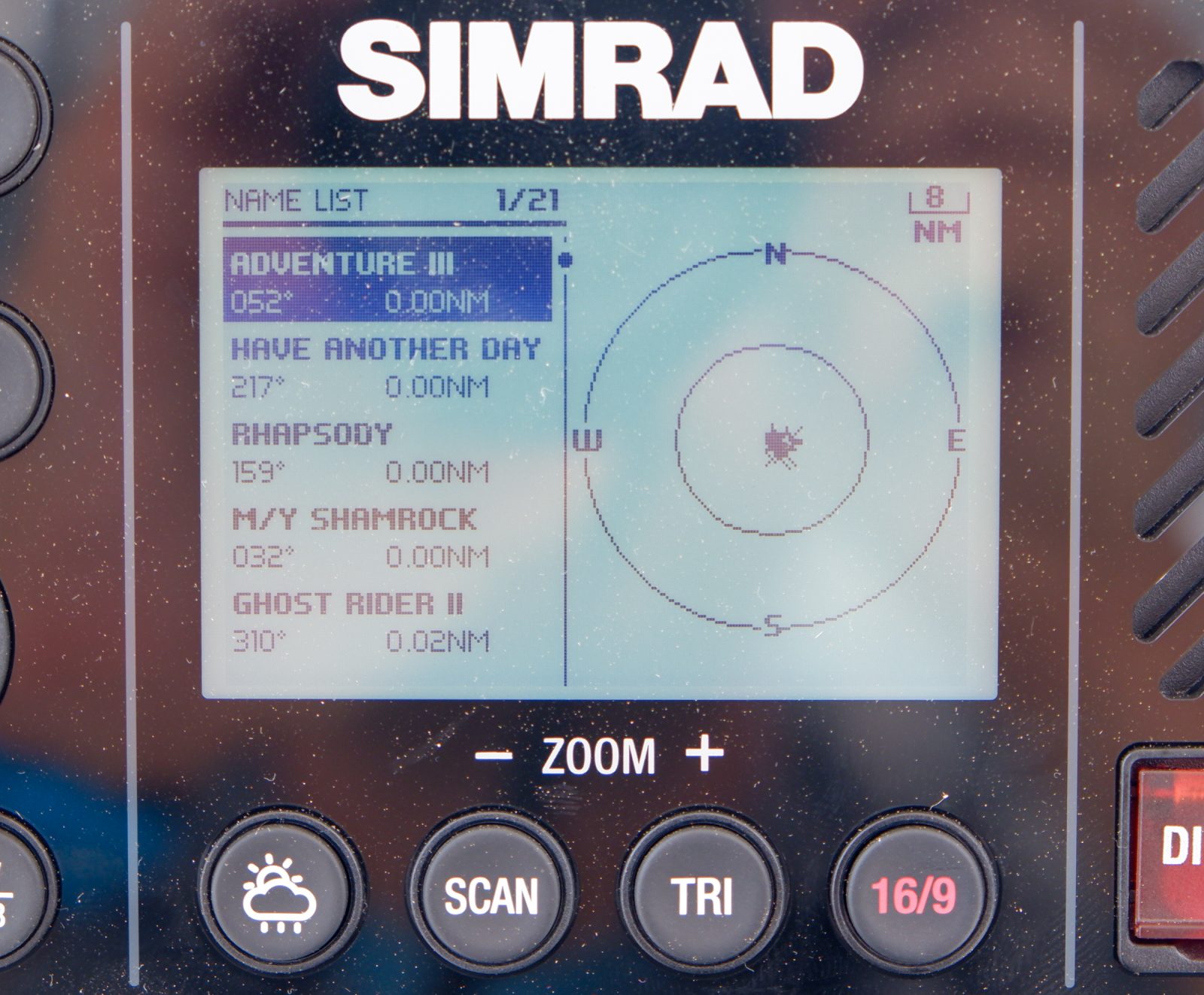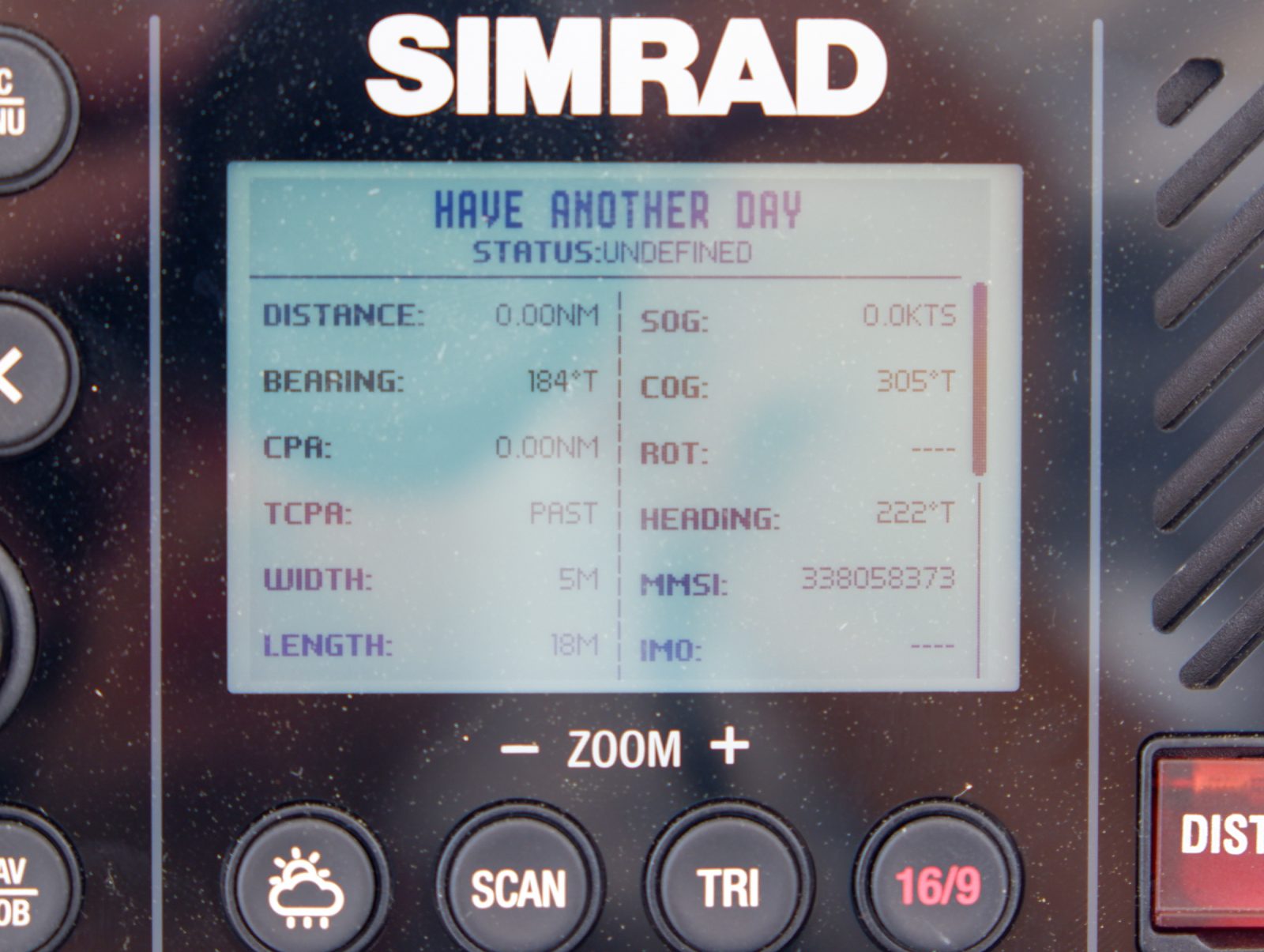Simrad RS40-B, the first VHF radio with AIS transceiver

AIS and VHF voice radios operate in the same frequency band, so it’s a natural step to combine the two functions into one device. But, combining a VHF radio and AIS transceiver has proved difficult. Although other manufacturers have tried, Simrad and B&G are the first to make it through approvals and ship radios to boaters. But how does the radio perform in the real world and is this a good choice for all your VHF communications needs?
The Simrad RS40-B — and the B&G V60-B from its Navico sibling — was announced in June of 2019 with an $1,100 list price. This full featured radio can support up to two wireless handhelds and also has front and rear connections for the included speaker mic. There’s a hailer with listen back and fog horn when the radio is connected to an external speaker. The radio has NMEA 2000 and 0183 connectivity for sharing AIS data. Plus, there’s a GPS receiver and antenna built into the radio, so as long as the radio has a clear view of the sky it won’t need an external GPS antenna for AIS or DSC.
VHF radio functionality
The RS40-B checks nearly every box for a VHF radio. With DSC, dual-watch, tri-watch, scanning, weather, intercom, and many other features, the only major feature I’ve noticed missing is a replay buffer. Plus, because of the GPS receiver built-in, DSC position functions including distress work out of the box with just the MMSI input into the radio.

The speaker mic has volume, channel, 16/9 quick access button and high / low power selector. It feels good in the hand and the buttons are nicely laid out to allow quick control of the radio from the hand mic. I’ve installed the radio on the helm of Panbo(at), my center console, which can be loud when moving along at 25 knots. I frequently have to turn the radio up to maximum volume to hear it over the wind and sometimes wish for a little more volume, but there is a connection for an external speaker. The audio quality is good from the radio, the wireless handset, and the speaker mic.
Wireless handset
The RS40-B supports up to two $220 HS40 wireless handsets per radio. The wireless handsets are nearly full function remotes of the RS40-B allowing use of all features including VHF voice communications and AIS except for the hailing and fog signalling features. The HS40 includes a charging cradle that holds and wirelessly charges the handset. The handsets communicate with the radio using 2.4ghz WiFi and though I’ve sometimes criticized the use of the 2.4ghz band I haven’t had any issues with interference or range while using the wireless handset (I’ve had similar successful results with Raymarine Ray90 VHF and its wireless handhelds).
Channel numbering

I was initially stymied by the radio’s use of the new channel numbering scheme that moves channels previously designated with an A to a four digit number starting with 10. This means that while the U.S. Coast Guard still broadcasts that their scheduled marine broadcasts can be heard on 22A you will need to tune this radio — and any others that follow the new numbering system — to 1022 instead. The A and B designations after channels are a vestige of the intent to use these channels in duplex mode with a separate frequency for transmit and receive. I should note that while I was confused — and I think others might be also — I don’t believe Simrad or any other radio manufacturers have a choice about adopting the new numbering system.
AIS

The RS40-B has a built-in Class B C/S AIS transceiver; to my knowledge it’s the first VHF radio with a built-in AIS transceiver to make it to boaters’ hands. Standard Horizon’s GX6500 was announced in late 2016 but apparently fell victim to issues during the approval process. Although the Navico radios were announced in 2019 the AIS transceiver in the unit is C/S rather than the higher powered and potentially faster updating SOTDMA (see our C/S vs SOTDMA primer). I suspect Navico may have played it safe with tried and true technology in order to ensure regulatory passage.
Vesper’s Cortex (Panbo previewed here) looks like it will be the first combination VHF radio and B/SO AIS unit to ship if they’re able to meet their March estimate for shipping the first units. Also, because Cortex uses a single radio for AIS and VHF, unlike the two separate radios in the RS40-B, only one antenna is required.
AIS configuration is handled through the user interface of the radio; unlike most AIS units I’ve configured there’s not an option to configure it through a PC. But, I found configuring AIS through the radio’s interface painless. AIS functionality in the RS40-B is comparable to standalone transceivers from B&G, Garmin, Raymarine, and Simrad but lacks some of the premium features like WiFi, mobile apps, and richer features of AIS receivers from ACR, Em-Trak, Si-Tex, and Vesper.
The RS40-B has separate antenna connections for VHF/DSC communications and AIS so you will either need two antennas on-board — as I have on Panbo(at) — or an antenna splitter. The physical installation of the radio is very easy with just a VHF antenna and power connections required to get started but without an internal splitter you will need an external one or another antenna to enable AIS.

With AIS enabled, targets begin to display quickly and I’ve seen no issues with displaying those targets either on the radio’s display or on a NMEA 2000 connected MFD. The radio’s interface allows you to select any of the targets and display detailed information on it. I haven’t been able to find a way to change the vessel details from metric to US units.
The only AIS alarming built into the unit is closest point of approach (CPA) alarms. Based on a user settable threshold the radio will alarm if an AIS target will come within the CPA threshold you’ve defined. Any further alarming would need to come from an MFD or other device connected to the RS40-B via NMEA 2000. Most AIS units on recreational boats are small boxes mounted below the dash somewhere without a visible user interface. The RS40-B is going to be mounted in a prominent location where the display is easily visible so I think the lack of additional alarming and display filtering is a missed opportunity.
Final thoughts
The RS40-B is a nice package with VHF and AIS communications built into a single compact box. As a VHF radio it works very well and I’ve found the user interface to be well thought out and easy to use. It’s a solid AIS transceiver without a ton of bells and whistles. At $1,100 list price it’s a little cheaper than an RS-40 (the model without an AIS transceiver) which lists for $620 and Simrad’s NAIS-500 AIS transceiver which lists for $720. So the pair would run about $1,340. On the other hand, a Standard Horizon GX6000 can be bought for $400 (or an Icom M506) and an AMEC B600W (with SOTDMA AIS and WiFi built in) for $690 which brings the total to $1,090 and adds several additional features. But, on a small boat with limited helm and electronics space, like Panbo(at), I’m happy to have everything contained in one small package.















Nice in-depth review, Ben.
Though I haven’t tested this radio as you did, I have held the microphone on display, that you described as feeling “good in the hand…” I suppose this is subjective, but to me it felt just the opposite – and the awkward-looking appearance and mount is obviously from the marketing department, not the engineering folks. Sorry, but the mike alone makes this a non-starter for me…
Definitely subjective. The hang up device for the mic isn’t as fast as the traditional button, but I really like that it holds the mic in the proper orientation. As you can see in the photos the mic is installed so that the cord is pulling the bottom to the left, with a button mount the mic would always sit a little crooked, with the hanger Simrad uses it stays in the proper orientation. Plus, I find the button layout really good, with the mic mounted on the dash I can easily reach forward (it’s just above and left of the steering wheel so very convenient to reach out and use the mic’s buttons) and adjust volume or channels.
These factors cause me to describe it favorably. I certainly understand you might have a different conclusion if your mounting and usage are different.
-Ben S.
Does anyone know if the transceiver will be added to the RS90S black box which currently only has an AIS receiver!
So they beat Vesper to the punch?
But I’ll wait for the Vesper. Compared to the Cortex, this seems more like a tack-on product, rather than innovation. Maybe. That said, I’m glad others are getting into the fray.
Ben, Thanks for this posting, which I found very interesting.
I have the RS-40 and would be thinking about adding the NAIS 500 Transceiver. Would this require a separate VHF antenna? I also note that AMEC and other manufacturers offer the AIS Class B transceiver for a lot less than $720. AMEC, for example, has one for $420. Is it worth staying in the same family of products? Aria has a B&G MFD in addition to the RS-40 VHF.
Any comments would be appreciated!
Peter
Good to hear from you, Peter. AIS is one area where staying with the same brand doesn’t usually benefit you much. And, yes, you will need either a second antenna or an AIS/VHF splitter, with the latter probably preferable on a sailboat like Aria. I suspect your best bet is a Class B CS model with a splitter built in, and I’d look hard at the latest 92x series from Em-Trak discussed at the end of this entry:
https://panbo.com/class-b-ais-so-cs-transmit-rates-truth-vs-confusion/
I also recommend working with Milltech Marine. They are specialists who sell AMEC, Em-Trak and many other AIS brands at fair prices and can advise you expertly:
https://www.milltechmarine.com/
Addition to my previous comment:
The AMEC CAMINO-108S CLASS B AIS TRANSPONDER WITH INTEGRATED SPLITTER lists for $545.
I note that to add a splitter to the NAIS-500 Class B Transponder costs an additional $249, putting the cost for NAIS-500 plus splitter up to just under $1000. So if the AMEC’s are any good, this would seem the right way to go. Comments?
Sorry, Peter, just saw this second comment, but it seems like we’re on the same page. Yes, the Camino should work fine for you, and there are some other choices close to that sale price at Milltech.
Thanks for doing this. I have been excited about this concept ever since Standard Horizon came out with theirs, (almost) and have been checking a few times a year to see if they have ever gotten it through approval. This one appears to be a VHF and AIS just crammed into a single box. With some interface, of course. Even tho I have all B&G on board, (not my choice), I am not sure I am ready to jump on this yet. I hate to keep waiting for the next best thing, B/C it seems to be a good way to wait your life away. But I think I will. Maybe this will encourage one of the real radio makers to jump out there. Also, I appreciate your High Def Pictures.
I’ve used one of these and it works as advertised. Such a good idea! Almost purchased one for a retrofit project (AIS is such a good idea) until I saw it doesn’t have an integrated splitter which makes it a non-starter. The FCC regulations/testing must be very tough.
Lance,
I definitely agree that the lack of an onboard splitter is really unfortunate. I suppose the thought process may have been focused on giving you the best possible performance by not requiring the use of a splitter. But if they could have found a way to split by default and offer separate connections, perhaps that would have been the best of both worlds.
-Ben S.
hy every one i have question
my ais simrad rs 40 cant transmit i need your advice
thanks
The RS40 is receive only. The RS40-B is send/receive.
You need to confirm which model you have.
I have just purchased the RS40B unit for my 6.7 fishing boat. And will be installed in a few months time.
Does this unit accept the newer AIS frequency bands (AIS 3 and AIS 4)?
Will this single antenna (P6102 – Pacific Aerials) be able to accomodate all 4 x AIS frequencies with the use of an external splitter?
Cameron
Hi Cameron,
There are two more approved AIS channels, apparently meant for satellite AIS monitoring, but I don’t know of any AIS transponders that use them. The website Continuous Wave has more information on this subject, and predicted new 4-channel AIS units last year, but I’d sure be interested if such a device actually exists yet:
https://continuouswave.com/forum/viewtopic.php?f=13&t=6630&p=38679&hilit=long+range+ais#p38679
I installed a RS40-B in August, 2023 and can’t get the transponder to send a signal. Would you mind shearing how you hooked your radio up.
Francis
Sounds like you may need to run through the manual.
Have you got an MMSI for your vessel?
In Australia, you need a radio operator’s license and then use that to apply to the Australian Maritime Safety Authority for an MMSI.
Without an MMSI entered into the radio, the DSC Distress and AIS transmit functions are disabled.
Hi Francis, Do you mean that you can’t see your boat as an AIS target on Marine Traffic or that you know for sure that it is not transmitting AIS info? Meanwhile, the Ben from Australia is right that no AIS transciever will transmit unless an MMSI number has been programmed into the radio. Also, the Ben who wrote this entry has not yet spoken up. Lots of Bens!
Ben I have been using proAIS2 program for over 2 years to program Em-Trak devices and there is already Long range broadcast function, my Class B+ AIS is received by satellites.
Isn’t this already a function that uses the next 2 channels?
Excerpt from the proAIS2 manual::
Long range broadcast:
This setting enables/disables the transmission of Message 27, used for long range detection. It’s transmitted on a different channel (frequency) and typically received by satellites. This proAIS2 feature is supported by Class B SO products only.
Is there a set of steps to turn off or set the cpa alarm. Out of the box it is set seemingly to 10 miles. And goea.off constantly. Thanks